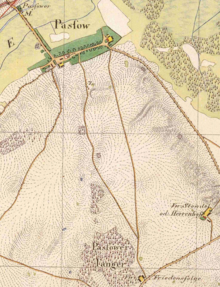Peacetime
Peace consequence was a Vorwerk south-southeast of Passow in the district of Uckermark ( Brandenburg ). It was built around / before 1816 and was probably not removed until after the Second World War .
location
The Vorwerk Friedenssequence was south-southeast of Passow or southwest of Herrenhof (town of Schwedt / Oder ) or north of Hohenlandin (Gem. Mark Landin ). No remains of the buildings have survived above ground. The area of the former Vorwerk is overgrown with bushes (location here ) and is today in the southern tip of the Passow district.
![]()
history
Around / before 1816 the von Di (e) ringshofen (also Düringshofen) built a Vorwerk on the manor Passow south of Passow, east of Schönermark and north of Hohenlandin, which was named Peace Succession with the approval of the government in Potsdam. In the locality directory of the government district of Potsdam according to the latest district division from 1817 it is already listed, but still without residents. In 1819 the residential building is described as a family house with four rooms. In the Urmes table sheet 2850 Passow from 1827 the Vorwerk Peace Succession on the Passower Tanger is shown.
The topographical-statistical overview of the government district of Potsdam and the city of Berlin from 1841 (status: 1840) shows a house with 12 residents. In 1852 there are 14 residents. For 1860 a residential house and two farm buildings are named. 12 people lived on the Vorwerk. According to the historical local dictionary for Brandenburg part VIII Uckermark , the Vorwerk still existed in 1931. It is not known when it went off.
Ownership
Since the middle of the 18th century, Passow was in full possession of the von Diringshofen (also Dieringshofen or Düringshofen). The creation of the outworks for the Peace Succession was carried out by the owner of the manor in Passow, Ludwig August von Diringshofen. He was a district deputy and later set up a house fideikommiss.
literature
- Lieselott Enders : Historical local dictionary for Brandenburg. Part VIII Uckermark . Hermann Böhlaus successor, 1210 pages, Weimar 1986, ISBN 3-7400-0042-2 .
Individual evidence
- ^ Official Journal of the Royal Government of Potsdam, year 1817, 1st part, from January 3, 1817, p. 8.
- ↑ Ortschafts = directory of the government = district of Potsdam according to the latest district division from 1817, with a note of the district to which the place previously belonged, the quality, number of people, confession, ecclesiastical circumstances, owner and address, along with an alphabetical register . Georg Decker, Berlin 1817 (without pagination) online at Google Books .
- ↑ August von Sellentin: Topographical-statistical overview of the government district of Potsdam and the city of Berlin: Compiled from official sources. 292 p., Verlag der Sander'schen Buchhandlung, 1841 Central and State Library Berlin: Link to the digitized version (p. 48).
- ↑ Eduard Messow: Topographical-Statistical Handbook of the Prussian State or: Alphabetical directory of all cities, towns, villages, manors, farms, mills, or other inhabited facilities, factories and properties which have their own name, with the exact description of the latter; also: indication of the province, the administrative district, the district and the mayor's office; the lower and higher judicial authorities; of the Landwehr Battalion, Regiment and Landwehr Brigade; the parish church, or parish; the number of hearths and souls in each place; the post office next to the place along with their properties, and finally the customs and tax authorities. 462 p., Verlag von Gebrüder Baensch, 1854, p. 210.
- ↑ Richard Boeckh: Local statistics of the government district Potsdam with the city of Berlin. 276 p., Verlag von Dietrich Reimer, Berlin, 1861, p. 44 (under Passow).
Coordinates: 53 ° 7 ' N , 14 ° 8' E
